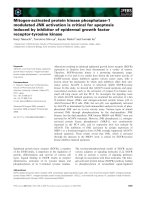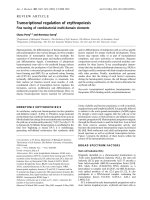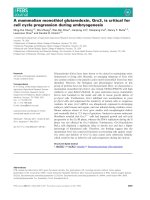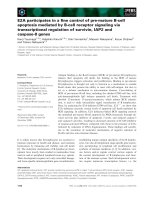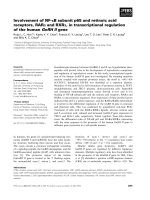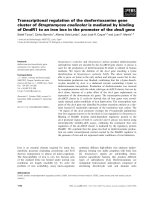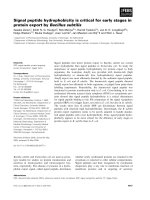TRANSCRIPTIONAL REGULATION OF ATF4 IS CRITICAL FOR CONTROLLING THE INTEGRATED STRESS RESPONSE DURING eIF2 PHOSPHORYLATION
Bạn đang xem bản rút gọn của tài liệu. Xem và tải ngay bản đầy đủ của tài liệu tại đây (4.7 MB, 127 trang )
TRANSCRIPTIONAL REGULATION OF ATF4 IS CRITICAL FOR
CONTROLLING THE INTEGRATED STRESS RESPONSE DURING eIF2
PHOSPHORYLATION
Souvik Dey
Submitted to the faculty of the University Graduate School
in partial fulfillment of the requirements
for the degree
Doctor of Philosophy
in the Department of Biochemistry and Molecular Biology
Indiana University
May 2012
!
!
ii
Accepted by the Faculty of Indiana University, in partial
fulfillment of the requirements for the degree of Doctor of Philosophy.
________________________________
Ronald C. Wek, Ph.D., Chair
________________________________
Howard J. Edenberg, Ph.D.
Doctoral Committee
________________________________
Patricia Gallagher, Ph.D.
February 29, 2012
________________________________
John J. Turchi, Ph.D.
!
!
iii
DEDICATION
This thesis is dedicated to my loving wife Arpita Mondal, my father Mr. Subrata
Dey and mother Mrs. Keya Dey. Without their care, support and motivation it would
have been extremely difficult for me to carry out my doctoral thesis dissertation.
!
!
iv
ACKNOWLEDGEMENTS
First and foremost, I am extremely indebted to Dr. Ron Wek for his guidance and
mentorship during my graduate career. He inspired me to pursue a career in academics
and I hope to continue following his advice and invaluable lessons into the future. I
would also like to thank my committee members, Dr. Howard Edenberg, Dr. Patricia
Gallagher, and Dr. John Turchi for their invaluable advice in successfully completing my
project. I am especially indebted to Sheree Wek for her advice and technical help
throughout my graduate career. I would also like to thank the members of the Wek lab
including Lakshmi Reddy Palam, Brian Teske, Thomas Baird for their technical advice,
training, and friendship. A special thanks to former lab members Dr. Kirk Staschke, Dr.
Donghui Zhou and Li Jiang for their technical help.
On a more technical note, I would like to thank Dr. Maria Hatzaglou, Dr. Cornelis
Calkhoven and Dr. Dan Spandau for plasmids and cell lines and sharing their
experimental expertise.
!
!
!
v
ABSTRACT
Souvik Dey
TRANSCRIPTIONAL REGULATION OF ATF4 IS CRITICAL FOR
CONTROLLING THE INTEGRATED STRESS RESPONSE DURING eIF2
PHOSPHORYLATION
In response to different environmental stresses, phosphorylation of eIF2 (eIF2~P)
represses global translation coincident with preferential translation of ATF4. ATF4 is a
transcriptional activator of the integrated stress response, a program of gene expression
involved in metabolism, nutrient uptake, anti-oxidation, and the activation of additional
transcription factors, such as CHOP/GADD153, that can induce apoptosis. Although
eIF2~P elicits translational control in response to many different stress arrangements,
there are selected stresses, such as exposure to UV irradiation, that do not increase ATF4
expression despite robust eIF2~P. In this study we addressed the underlying mechanism
for variable expression of ATF4 in response to eIF2~P during different stress conditions
and the biological significance of omission of enhanced ATF4 function. We show that in
addition to translational control, ATF4 expression is subject to transcriptional regulation.
Stress conditions such as endoplasmic reticulum stress induce both transcription and
translation of ATF4, which together enhance expression of ATF4 and its target genes in
response to eIF2~P. By contrast, UV irradiation represses ATF4 transcription, which
diminishes ATF4 mRNA available for translation during eIF2∼P. eIF2~P enhances cell
survival in response to UV irradiation. However, forced expression of ATF4 and its target
gene CHOP leads to increased sensitivity to UV irradiation. In this study, we also show
!
!
vi
that C/EBPβ is a transcriptional repressor of ATF4 during UV stress. C/EBPβ binds to
critical elements in the ATF4 promoter resulting in its transcriptional repression. The LIP
isoform of C/EBPβ, but not the LAP version is regulated following UV exposure and
directly represses ATF4 transcription. Loss of the LIP isoform results in increased ATF4
mRNA levels in response to UV irradiation, and subsequent recovery of ATF4
translation, leading to enhanced expression of its target genes. Together these results
illustrate how eIF2~P and translational control, combined with transcription factors
regulated by alternative signaling pathways, can direct programs of gene expression that
are specifically tailored to each environmental stress.
Ronald C. Wek, Ph.D., Chair
!
!
vii
TABLE OF CONTENTS
LIST OF FIGURES x
ABBREVIATIONS xii
INTRODUCTION 1
1. Phosphorylation of eIF2α – a critical event in cellular stress responses 1
2. Role of eIF2α~P in disease 2
3. eIF2α~P is critical for regulating cellular translation 4
4. Exchange of eIF2-GDP to eIF2-GTP is regulated during cellular stress 4
5. Dephosphorylation of eIF2α~P 6
6. GCN2 facilitates translational control in response to nutrient starvation 7
7. GCN2 functions in conjunction with additional stress pathways to
mitigate cell damage 8
8. PERK functions in the unfolded protein response during endoplasmic
reticulum stress 10
9. HRI directs translational control in erythroid tissues 11
10. PKR facilitates an anti-viral defense pathway 11
11. Activation of ATF4 occurs in response to cellular stresses 13
12. Phosphorylation of eIF2α increases ATF4 expression 15
13. eIF2α~P regulates several downstream ISR genes 18
14. ATF4 activates several downstream transcription factors in the ISR 23
15. Differential regulation of the ISR 24
16. The role of the ISR in determining cellular fate following stress 27
17. Dysregulation of the ISR can lead to diseases 29
!
!
viii
METHODS AND MATERIALS 32
1. Cell Culture and Stress Conditions 32
2. Plasmid constructions 33!
3. Immunoblot Analysis 35!
4. Polysome Analyses 36!
5. Isolation of RNA and Real Time PCR 37!
6. Luciferase Assays 38!
7. Cell Survival Assays 38!
8. Chromatin Immunoprecipitation 39!
RESULTS 41
1. Both transcriptional regulation and translational control of ATF4
are central to the Integrated Stress Response 41
1.1 UV irradiation induces eIF2α~P without activation of
ATF4 and CHOP 41!
!
1.2 eIF2α~P by UV irradiation reduces global protein synthesis 42
1.3 ATF4 mRNA is lowered in response to UV irradiation 46
1.4 ATF4 mRNA is short-lived independent of stress 47
1.5 ATF4 transcription is repressed in response to UV irradiation 47
1.6 eIF2α~P Is important for cell survival in response to UV-C 54
2. Transcriptional repression of ATF4 by C/EBPβ 61
2.1 ATF4 expression is significantly reduced in response to UV irradiation
despite robust eIF2α~P 61
2.2 The ATF4 promoter contains elements responsible for transcriptional
!
!
ix
repression 62
2.3 C/EBPβ represses the ATF4 promoter 67
2.4 Expression of the C/EBPβ isoforms is differentially regulated in response
to UV and ER stress 69
2.5 LIP is a potent repressor of ATF4 transcription 74
2.6 Loss of the C/EBPβ isoform LIP increases expression of
ATF4-target genes 80
DISCUSSION 85
1. ATF4 is transcriptionally repressed following UV irradiation 85
2. C/EBPβ represses ATF4 transcription 87
3. The combination of transcriptional and translational control allows for
differential expression of ISR target genes 89
4. Regulation of ATF4 transcription in response to various stress conditions 93
REFERENCES 96
CURRICULUM VITAE
!
!
x
LIST OF FIGURES
1. eIF2α kinases regulate translation in response to various cellular stress
conditions 3
2. Regulation of eukaryotic translation initiation 5
3. The eIF2α kinase family 12
4. Preferential translation of ATF4 is induced by eIF2α~P 16
5. Phosphorylation of eIF2α regulates translation of several ISR genes 21
6. Translation control of C/EBP
β
regulates synthesis of three isoforms 22
7. Differential regulation of Integrated Stress Response 26
8. UV irradiation elicits eIF2~Pα in the absence of induced ATF4 and CHOP 43
9. UV-C and UV-B irradiation induces eIF2α~P in different cell types 44
10. Phosphorylation of eIF2α reduces translation initiation in
response to UV irradiation or ER stress 45
11. Levels of ATF4 mRNA are reduced in response to UV irradiation 50
12. ATF4 transcription is regulated during stress 52
13. Phosphorylation of eIF2α provides for resistance to UV irradiation 57
14. Expression of ATF4 and CHOP elicited by pretreatment with
salubrinal reduces viability of cells during UV stress 59
15. Expression of ATF4 is blocked during UV irradiation despite
increased eIF2α~P 64
16. The ATF4 promoter contains critical elements for repression in
response to UV irradiation 66
!
!
xi
17. C/EBPβ is required for reduced ATF4 mRNA in response to
UV irradiation 70
18. C/EBPβ binds to the specific elements in the ATF4 promoter 72
19. C/EBP
β
mRNA is stabilized following UV treatment 75
20. The LIP and LAP isoforms of C/EBPβ are differentially expressed
during UV and ER stress 76
21. LIP is a potent repressor of ATF4 transcription 77
22. Loss of LIP in C/EBP
β
-
Δ
uORF cells alleviates repression of
ATF4 transcription 82
23. Alleviation of ATF4 repression in C/EBP
β
-
Δ
uORF cells causes increased
expression of ATF4-target genes in response to UV irradiation 84
24. Model depicting proposed transcriptional and translation control of
ATF4 expression and the ISR 92
25. A combination of transcriptional and translational control of ATF4
directs the gene expression program of the ISR 95
!
!
xii
ABBREVIATIONS
4E-BP eIF4E-Binding Protein
ATF3 Activating Transcription Factor-3
ATF4 Activating Transcription Factor-4
ATF5 Activating Transcription Factor -5
bZIP Basic Leucine Zipper
BCL B-Cell Lymphoma
BIM Bcl-2 Interacting Mediator of cell death
CARE CCAAT-enhancer binding protein Activating transcription factor
(C/EBP-ATF) Response Element
CACH Childhood Ataxia with Central nervous system Hypermyelination
CHOP C/EBP Homologous Protein
DMEM Dulbecco's Modified Eagle's Media
DNA-PKc DNA – Protein Kinase C
DTT Dithiothreitol
DR5 Death Receptor 5
dsRNA double-stranded RNA
dsRBMD double-stranded RNA Binding Motif
EBER Epstein-Barr Virus Small RNA
eIF2 Eukaryotic Initiation Factor 2
eIF2Β Eukaryotic Initiation Factor-2Β
eIF2~P Eukaryotic Initiation Factor-2 Phosphorylation
ER Endoplasmic Reticulum
ERO1 ER Oxidoreductase 1
!
!
xiii
GAP GTPase-Activating Protein
GDP Guanosine Diphosphate
GTP Guanosine-5'-Triphosphate
GCN2 General Control Nonderepressible -2
GDI GDP-Dissociation Inhibitor
GADD34 Growth Arrest and DNA Damage-inducible protein-34
GRP78 Glucose-Related Protein 78
HisRS Histidyl-tRNA Synthetase
HRI Heme Regulated Inhibitor
ISR Integrated Stress Response
IRE1 Inositol Requiring Enzyme -1
IkΒα Inhibitor of NF-κB alpha
LAP Liver-Enriched Activating Protein
LIP Liver-Enriched Inhibitory Protein
Met-tRNA
i
Methionyl-Initiator tRNA
MEF Mouse Embryonic Fibroblast
MMS Methyl Methane Sulfonate
NASH Non-Alcoholic Steatohepatitis
NER Nucleotide Excision Repair
NF-κB Nuclear Factor -κB
NRF2 Nuclear Factor-like 2
PCR Polymerase Chain Reaction
PKR double-stranded RNA-activated Protein Kinase
!
!
xiv
PEK Pancreatic eIF2 kinase
PERK PKR-Like ER kinase
QRT-PCR Quantitative real time PCR
ROS Reactive Oxygen Species
RSK2 Ribosomal S6 kinase 2
Runx2 Runt-Related Transcription Factor -2
S6K S6 Protein Kinase
SNAT2 System A neutral Amino acid Transporter 2
TC Ternary Complex
TOR Target-of-Rapamycin
TRB3 Tribbles-Related Protein -3
UPR Unfolded Protein Response
UTR Untranslated Region
uORF upstream Open Reading Frame
WRS Wolcott-Rallison Syndrome
!
!
1
INTRODUCTION
1. Phosphorylation of eIF2α – a critical event in cellular stress responses
In response to various environmental stress conditions, eukaryotic cells regulate
protein synthesis by dampening global translation. This allows the cells to conserve their
cellular energy and begin to alleviate the stress damage. Central to this response is a
family of protein kinases that phosphorylate the α subunit of eukaryotic initiation factor 2
(eIF2) at serine-51 residue (1). Four different eIF2α kinases have been identified in
mammals, including the General control nonderepressible kinase-2 (GCN2), Heme
regulated inhibitor (HRI), Double-stranded RNA-activated protein kinase (PKR) and
Pancreatic eIF2 kinase (PEK) or PKR-like ER kinase (PERK) (Figure 1) (2). While
higher eukaryotes express all four of the eIF2α kinases, yeast Saccharomyces cerevisiae
contains only a single version, GCN2. The family of eIF2α kinases exhibit sequence
homology in their kinase catalytic domains, but diverge significantly in their regulatory
regions, thus enabling each to act as a unique sensor during different types of cellular
stresses (Figure 3).
Phosphorylation of eIF2α during diverse stress conditions leads to a program of
translational and transcriptional regulation known as the Integrated Stress Response
(ISR). The ISR is activated by sequential expression of a set of factors that function to
alleviate the cellular stress, or alternatively induce apoptosis (2, 3). The ISR can be
divided into three major steps. The initial step is the recognition of stress conditions by
the stress kinases, leading to phosphorylation of eIF2α (Figure 1). The second step of the
ISR involves a decrease in global protein synthesis, coincident with preferential
translation of select mRNAs encoding transcription factors, such as ATF4 (4, 5). The
!
!
2
final step of the ISR involves transcriptional expression of the ATF4-target genes, which
resolve the stress for cellular survival, or alternatively trigger apoptosis if the stress is
chronic and/or the cellular damage is beyond repair. The ISR is activated in response to a
myriad of different stress conditions, although there can be unique modulation of the
pathway depending on the particulars of the stress arrangement. Each of the three steps
of ISR and their key regulatory features will be reviewed in detail in the following
chapters.
2. Role of eIF2α~P in disease
Mutations in the ISR signaling can cause disease. Loss of PERK is the basis of
patients with Wolcott-Rallison Syndrome (WRS), which features neonatal diabetes,
osteoporosis, hepatic and kidney dysfunction, exocrine pancreatic disorders, neutropenia
and early death (6-9). Previous study has shown that GCN2
-/-
mice fed on a leucine-
deprived diet showed a marked loss of skeletal muscle mass compared to their wild-type
littermates, with about 40% of the GCN2
-/-
mice expiring within three days of the nutrient
stress (10). PERK and GCN2 have also been shown to play a role in adaptation of solid
tumor to hypoxia and nutrient-deprived conditions, respectively, in mouse and human
xenograft caner models (11, 12). Loss of PKR in mice has also been shown to lead to
increased susceptibility to viral infection (13, 14), while HRI
-/-
mice deprived of iron
show enhanced anemia with significant reductions of red blood cells counts, along with
compensatory erythroid hyperplasia and increased apoptosis in bone marrow and spleen
(15).
!
!
3
!
!
!
!
!
Figure 1. eIF2α kinases regulate translation in response to various cellular stress
conditions. In response to diverse environmental stresses, a family of protein kinases,
PKR, HRI, PERK and GCN2 phosphorylates eIF2α at the serine-51 residue in response
to distinct stress conditions. Phosphorylation of eIF2α reduces the eIF2-GDP to eIF2-
GTP exchange by inhibiting the guanine nucleotide exchange factor, eIF2B. Reduced
eIF2-GTP levels subsequently lower translation initiation, resulting repression of global
protein synthesis.
!
!
!
!
!
!
!
4
3. eIF2α~P is critical for regulating cellular translation
The eIF2 consists of three different subunits - α, β and γ, and plays a central role
in translation initiation. During translation, eIF2 binds with initiator methionyl-tRNA
and GTP to form a ternary complex (eIF2-TC), which then combines with the 40S
ribosomal subunit in a pre-initiation complex that associates with the 5'-cap and
associated proteins of the target mRNA (16). The small ribosomal complex then scans 5'
to 3' along the leader of the mRNA. Once an appropriate initiation codon is found in the
mRNA and initiator tRNA bound to this codon is placed into the P site of the ribosome,
the 60S ribosomal subunit is recruited to form a translation-competent 80S ribosomal
complex. Formation of the 80S subunit is preceded by release of eIF2 combined with
GDP, which was hydrolyzed during the initiation process (17, 18). The eIF2-GDP is
subsequently recycled to its active GTP form by a guanine nucleotide exchange factor
known as eIF2B (Figure 2).
4. Exchange of eIF2-GDP to eIF2-GTP is regulated during cellular stress
The eIF2B consists of α, β, γ, δ and ε subunits. While γ and ε are the catalytic
core of eIF2B, the subunits α, β, and δ form its regulatory subunits (19-21). There is
sequence similarity between the mammalian subunits α, β, and δ of eIF2B and their yeast
counterpart GCN3, GCD7, and GCD3 respectively. Studies in vitro and in vivo in
mammalian and yeast model systems have shown that phosphorylation of eIF2α at serine
51 converts eIF2 from a substrate to a competitive inhibitor of eIF2B (2, 22). As a
consequence, eIF2α phosphorylation reduces the levels of the eIF2-TC and subsequent
rounds of translation initiation. The reduced global protein synthesis provides cells time
!
!
5
!
!
!
!
Figure 2. Regulation of eukaryotic translation initiation. The translation initiation
factor eIF2 binds with GTP and initiator Met-tRNA
i
Met
along with the small 40S
ribosome, as well as additional translation initiation factors, resulting in a 43S
preinitiation complex. The 43S preinitiation ribosomal complex then binds to the 5’-cap
structure of mRNAs consisting of the 7’methyl guanosine cap and associated cap binding
protein eIF4F. The 43S ribosomal complex along with the associated eIF2 then scans
processively 5’ to 3’ direction along the mRNA until the starting AUG initiation codon is
recognized. With the placement of the initiator tRNA bound to the intiator codon in the P
site of the ribosome, the 60S ribosome joins to form the competent 80S ribosome,
allowing for the elongation phase of protein synthesis. Before the joining of the 60S
ribosomal subunit, eIF2-GTP is hydrolyzed to eIF2-GDP and Pi is released, completing
the step of translation initiation. The hydrolysis of eIF2-GTP is accelerated by the
GTPase activating protein (GAP) eIF5. Inactive eIF2-GDP is converted to its active GTP
bound form by the guanine nucleotide exchange factor eIF2B, facilitating subsequent
rounds of translation initiation. Phosphorylation of eIF2α converts it from a substrate to
an inhibitor of eIF2B. The resulting reduction in eIF2-GTP levels lowers general protein
synthesis. This allows the cells to conserve energy and recalibrate the genome by
expressing genes responsible for alleviation of the stress, or alternative for triggering cell
apoptosis.!
!
!
!
!
!
!
6
to recalibrate gene expression designed to block or remediate cellular damage during
stress.
The initiation factor eIF5 is another critical regulator for the nucleotide exchange
of eIF2. The eIF5 function as a GTPase-activating protein (GAP) for eIF2, contributing
to selection of the start site during the initiation phase of protein synthesis (Figure 2) (23).
However recent studies have revealed a new role of eIF5. In yeast, eIF5 was shown to
function as a GDP-dissociation inhibitor (GDI), which can stabilize the eIF2-GDP state.
A C-terminal domain of eIF5 can bind to eIF2-GDP and inhibit eIF2B function, thus
preventing the eIF2-GDP to eIF2-GTP exchange (24). Therefore, eIF5 can contribute to
decreased eIF2-GTP levels, aiding the ISR block of global protein synthesis.
5. Dephosphorylation of eIF2α~P
Phosphorylation of eIF2α represses of protein synthesis, which if sustained can
contribute to cellular apoptosis. To restore translation, cells have feedback mechanisms
in the ISR which includes proteins that can contribute to dephosphorylation of eIF2.
These include GADD34 (Ppp1r15a) and CReP (Ppp1r15b), which act as regulatory
subunits for the catalytic subunit of protein phosphatase type 1 (PP1c) that facilitates
dephosphorylation of eIF2α~P (25). Unlike CReP which is constitutively expressed (26),
GADD34 levels are low in unstressed conditions. During stress, GADD34 is
transcriptionally induced by ATF4 (27, 28). Additionally, expression of GADD34
mRNA is subject to preferential translation in response to eIF2α~P (29). The resulting
elevated levels of GADD34 can facilitate PP1c dephosphorylation of eIF2α~P and
resumption of protein synthesis (27). Thus dephosphorylation of eIF2α~P provides cells
!
!
7
a mechanism to attenuate translation repression, thus enhancing the synthesis of stress-
related mRNAs induced by the ISR.
6. GCN2 facilitates translational control in response to nutrient starvation
As noted above, diverse environmental stress conditions induce eIF2α~P through
a family of different protein kinases. Such a wide-range of different stress conditions can
lead to enhanced expression of ATF4 and its target genes, thus activating the Integrated
Stress Response (ISR). One of the eIF2α kinases is GCN2 (EIF2AK4) that is present
from yeast to mammals and represses translation initiation in response to nutrient
starvation (2). GCN2 consists of multiple domains, which contribute to the mechanisms
regulating activation of the eIF2α kinase in response to starvation for nutrients. The
GCN2 domains include a RWD domain, pseudokinase domain, protein kinase domain,
histidyl-tRNA synthetase (HisRS)-related domain, and C-terminal domain that facilitates
GCN2 dimerization and its association with ribosomes (Figure 3) (30). The major
regulatory region that is important for GCN2 activation is the HisRS-regulated domain.
Amino acid starvation leads to accumulation of uncharged tRNAs, which can bind to the
HisRS-related domain and alter GCN2 to an activated conformation (31). Activated
GCN2 then leads to enhanced GCN2 auto-phosphorylation at the activation loop of the
catalytic domain, increasing eIF2α∼P and translation of ATF4 mRNA.
Ribosome association of GCN2 has been suggested to facilitate access of the
eIF2α kinase to uncharged tRNA (32). Additionally, the C-terminal domain is suggested
to act as an autoinhibitory region by binding to its kinase domain. Upon binding of
uncharged tRNA, this inhibitory C terminal domain has been suggested to be released
!
!
8
from the protein kinase domain (33, 34). The pseudo kinase domain is required for
eIF2α~P by GCN2. Currently, the mechanistic importance of the pseudo kinase domain
is not well understood, but it has been suggested to contribute to the dynamics of the
conformation change that occurs during activation of GCN2. Finally, the N-terminal
RWD domain is important for direct interaction with a positive acting-regulator GCN1,
which is thought to facilitate the delivery of uncharged tRNA to GCN2 (30).
GCN2 is also activated in response to other cytoplasmic stresses such as UV
irradiation and proteosome inhibition (35-37). However, the mechanisms for activation
of GCN2 in response to these stress conditions are not well defined. One proposed model
for GCN2 activation in response to UV is that induced iNOS levels leads to rapid
catalysis of L-Arginine to release reactive NO
*
. This causes depletion of L-Arginine in
the cells, which in turn activates GCN2 (38). Alternatively, UV irradiation may reduce
the levels of charged tRNA by directly interfering with aminoacyl-tRNA synthetase
charging of tRNA or by impeding nuclear export of tRNAs. Reduced proteasome
activity has also been suggested to reduce the reclamation of free amino acids from
degraded proteins, which may lower the charging of tRNAs.
7. GCN2 functions in conjunction with additional stress pathways to mitigate cell
damage
GCN2 interacts with other cellular stress pathways. The serine/threonine kinase
TOR acts as a sensor for nutrient condition. TOR is repressed by the drug rapamycin,
and in yeast, rapamycin leads to increased GCN2 phosphorylation of eIF2α (39).
Furthermore, leucine starvation in livers of GCN2
-/-
mice shows a dramatic reduction in
!
!
9
phosphorylation of TOR target protein, 4E-BP and S6K (40). Along with TOR, GCN2
also has regulatory links with the DNA-damage response kinase, DNA-PK. The activity
of DNA-PK was reported to be required for full GCN2 phosphorylation of eIF2α in
response to UV irradiation (41). It is suggested that DNA-PK may directly phosphorylate
GCN2, contributing to its activation during select stress conditions.
GCN2 can act as a pro-survival factor, or trigger apoptosis, depending on the
precise stress arrangement. GCN2 phosphorylation of eIF2α in response to UV
irradiation activates cellular survival pathways, such as that directed by NF-κB (36). NF-
κB is a key transcriptional factor controlling immune responses, cell proliferation, and
apoptosis (42-44). The global translation repression accompanying eIF2α~P
significantly reduces the synthesis of IκBα in response to UV irradiation (36). IκBα is
an inhibitory protein of NF-κB, binding with the transcription factor and keeping it in an
inactive state in the cytosol. IκBα is a labile protein and the lowered synthesis of IκBα
following UV irradiation lowers the levels of this inhibitory protein, allowing for
enhanced NF-κB entry into the nucleus and increased transcription of its target genes.
Loss of either GCN2 or NF-κB (RelA/p65 subunit) can lead to apoptosis following UV
exposure (36). However unlike the events occurring during UV stress, it was reported
that increased GCN2 phosphorylation of eIF2α upon exposure to drugs that block
proteasome function, such as MG132, leads to activation of a pro-apoptotic pathway
through ATF4 and its target CHOP (37). Therefore, GCN2 can function in combination
with various stress pathways to differentially activate genes that dictate cellular survival
or apoptosis. As mentioned above, GCN2
-/-
mice are sensitive to leucine starvation, with
loss of skeletal muscle to compensate for liver metabolism (10). Recent studies have also
!
!
10
suggested that GCN2 contributes to brain function, specifically the motor functions of the
hippocampus and the anterior piriform cortex (45). GCN2
-/-
mice exhibit reduced long-
term potentiation (LTP) directed by the hippocampus, as well as reduced learning ability
in behavioral tasks, such as conditioned taste aversion (45-49).
8. PERK functions in the unfolded protein response during endoplasmic reticulum
stress
PERK (EIF2AK3) is a type 1 ER resident transmembrane protein and
eIF2α kinase that is activated in response to accumulation of unfolded proteins in the
endoplasmic reticulum. The cytosolic portion of PERK contains the protein kinase
domain, while the ER luminal region contains the signal sequence and the regulatory
region that senses ER stress and facilitates dimerization between PERK polypeptides
(Figure 3). An important regulatory protein that controls the function of PERK is the
Glucose related protein 78 (GRP78/BiP), an ER resident chaperone that binds to the N-
terminal regulatory region of PERK, maintaining PERK in an inactive state during non-
stressed conditions (50). Accumulating misfolded proteins in the stressed ER can titrate
off the GRP78 from PERK, allowing PERK to dimerize and trans-autophophorylate (51).
As a consequence PERK is activated, leading to enhanced eIF2α~P and repressed global
translation, which would reduce further influx of newly synthesized proteins into the
stressed ER (52). An alternative model for related ER stress sensor IRE1 (Inositol
requiring enzyme 1), is that unfolded proteins can directly bind to the regulatory region
of PERK, facilitating enhanced eIF2α~P (52, 53). PERK functions in conjunction with
other ER resident factors IRE1 and ATF6 (Activating transcription factor 6), which
!
!
11
contribute to increased transcription of genes involved in the folding, processing, and
trafficking of secretory proteins (52). This pathway is collectively referred to as the
Unfolded Protein Response (UPR), a stress response pathway that serves to expand the
processing capacity of the secretory pathway.
9. HRI directs translational control in erythroid tissues
HRI (EIF2AK1) is an eIF2α kinase that is regulated by the availability of heme in
erythroid tissues (54, 55). HRI binds heme at two regions, one at the N terminus of HRI
and the other in the insert region within the kinase domain (Figure 3) (56). During non-
stressed conditions in erythroid tissues, heme associates with these two sites, rendering
HRI inactive. However during heme deprivation, heme is released from HRI, leading to
enhanced HRI phosphorylation of eIF2α and reduced translation, which in reticulocytes
is predominantly globin synthesis. As heme contains iron, HRI also acts a sensor for
cellular iron levels. Absence of HRI in mice leads to cellular sensitivity and apoptosis
during heme and iron deprivation, contributing to anemia, with decreased red blood cell
counts and compensatory erythroid hyperplasia accompanied by increased apoptosis in
the bone marrow and spleen (15).
10. PKR facilitates an anti-viral defense pathway
PKR (EIF2AK2) is expressed ubiquitously in all cells, but is induced upon
interferon treatment (14, 57, 58). Activation of PKR occurs in response to binding of
double-stranded RNA (dsRNA), which is generated during viral infections. PKR has two
dsRNA-binding motifs (dsRBMs) in its N terminus, with a C terminal protein kinase
